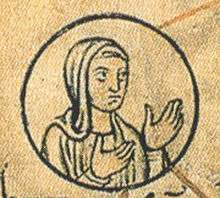Hedwig of Saxony
| Hedwige of Saxony | |
|---|---|
 Hedwig of Saxony, detail from the Chronica sancti Pantaleonis, 12th century | |
| Born | c. 910 |
| Died | after 958 |
| Spouse | Hugh the Great |
| Issue |
Hugh Capet Emma of Paris, Duchess of Normandy Otto, Duke of Burgundy Henry I, Duke of Burgundy |
| House | Ottonian dynasty (Liudolfings) |
| Father | Henry the Fowler |
| Mother | Matilda of Ringelheim |
Hedwige of Saxony (also Hedwig, German: Hadwig von Sachsen; c. 910 – after 958), a member of the Ottonian dynasty, was Duchess consort of the Franks by her marriage to the Robertian duke Hugh the Great. Upon her husband's death in 956, she acted as a regent during the minority of their son Hugh Capet, the founder of the Elder House of Capet.
Life
According to the medieval chronicler Widukind of Corvey, Hedwig was a younger daughter of the Saxon duke Henry the Fowler (c. 876 – 936), elected King of East Francia from 919, and his second wife Matilda of Ringelheim (c. 895 – 968). Her siblings were Otto I, who succeeded his father as king and was crowned Holy Roman Emperor in 962; Duke Henry I of Bavaria; Gerberga of Saxony, who married King Louis IV of France in 939; and Archbishop Bruno of Cologne.
After her brother Otto I came to power in 936, an alliance and marriage was arranged with the West Frankish duke Hugh the Great, who sought support in his struggles with King Louis IV. Hedwig was Hugh's third wife. They married probably in May 937.
When Hedwig's husband died in 956, her son Hugh Capet was still underage. Although Hugh inherited his father's estates, he did not rule independently from the beginning.[1] Along with her brother, Archbishop Bruno, Hedwig acted as Hugh's regent and administrator of the Robertian estates until he came of age.[2] Bruno also held guardianship over his nephew King Lothair of France, son of his sister Gerberga, and temporarily raised to one of the most powerful nobles in West Francia. Hedwig backed her brother in his conflict with Count Reginar III of Hainaut and arbitrated in the rivalry between her son Hugh Capet and King Lothair.
Hedwig is last mentioned in 958 by the West Frankish chronicler Flodoard of Reims and may have died soon afterward; a 965 entry by Sigebert of Gembloux seems doubtful.
Issue
- Beatrice married Frederick I, Duke of Upper Lorraine.[lower-alpha 1][3]
- Hugh Capet (c. 941 – 996), who was crowned King of France in 987.
- Emma of Paris (943–968), who married Duke Richard I of Normandy in 960.
- Otto, Duke of Burgundy (945–965)
- Henry I, Duke of Burgundy (946–1002)
References
- ↑ Riché, The Carolingians, p. 264
- ↑ Michelet, History of France, p. 146
- ↑ Detlev Schwennicke, Europäische Stammtafeln: Stammtafeln zur Geschichte der Europäischen Staaten, Neue Folge, Band II (Verlag von J. A. Stargardt, Marburg, Germany, 1984), Tafeln 10-11
- W. Glocker, Die Verwandten der Ottonen und ihre Bedeutung in der Politik. Studien zur Familienpolitik und zur Genealogie des sächsischen Kaiserhauses (1989).
- J. Michelet, History of France, Vol. I, trans. G. H. Smith (New York: D. Appleton, 1882).
- P. Riché, The Carolingians; A Family Who Forged Europe, trans. Michael Idomir Allen (Philadelphia: University of Pennsylvania Press, 1993).
Notes
- ↑ By his daughter Beatrice's marriage to Frederick I, Duke of Upper Lorraine Hugh became an ancestor of the Habsburg family. From their son Hugh Capet sprang the Capetian dynasty, one of the most powerful dynasties in Europe.
External links
- Medieval Lands Project
- Hadwig von Sachsen (in German)